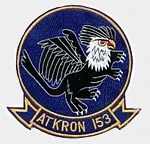Hobby Master HA7208 US Navy Grumman F9F-5 Panther Fighter - "The Blue Tail Fly", VF-153 "Blue Tail Flies", USS Princeton (CVL-23), 1953 (1:48 Scale)
"To Ted Williams - not only America's greatest baseball player, but a great American who served his country. Your friend, Douglas MacArthur. General U.S. Army."
- Inscription found on an oil painting of General Douglas MacArthur to Ted Williams celebrating his fortieth birthday
 The Grumman F9F Panther was the manufacturer's first jet fighter and the U.S. Navy's second. The Panther was the most widely used U.S. Navy jet fighter of the Korean War. It flew 78,000 sorties and was responsible for the first air kill by the US Navy in the war - the downing of a North Korean Yakovlev Yak-9 fighter. Total F9F production was 1,382, with several variants being shipped to Argentina for export.
The Grumman F9F Panther was the manufacturer's first jet fighter and the U.S. Navy's second. The Panther was the most widely used U.S. Navy jet fighter of the Korean War. It flew 78,000 sorties and was responsible for the first air kill by the US Navy in the war - the downing of a North Korean Yakovlev Yak-9 fighter. Total F9F production was 1,382, with several variants being shipped to Argentina for export.
Development studies at the Grumman company began near the end of the World War II as the first jet engines emerged. The prototype Panther, piloted by test pilot Corky Meyer, first flew on November 24th, 1947. Propulsion was a Rolls-Royce Nene turbojet built under license by Pratt & Whitney as the J42. Since there was insufficient space within the wings and fuselage for fuel for the thirsty jet, permanently-mounted wingtip fuel tanks were added which incidentally improved the fighter's rate of roll. It was cleared for flight from aircraft carriers in September 1949. During the development phase, Grumman decided to change the Panther's engine, selecting the Pratt & Whitney J48-P-2, a license built version of the Rolls-Royce Tay. The other engine that had been tested was the Allison J33-A-16, a development of the Rolls-Royce Derwent.
From 1946, a swept-wing version was considered and after concerns about the Panther's inferiority to its MiG opponents in Korea, a conversion of the Panther (Design 93) resulted in a swept-wing derivative of the Panther, the Grumman F9F Cougar, which retained the Panther's designation number.
Pictured here is a 1:48 scale replica of a US Navy Grumman F9F-5 Panther fighter that was attached to VF-153 "Blue Tail Flies", then embarked upon the USS Princeton (CVL-23) during 1953.
Sold Out!
Dimensions:
Wingspan: 9-1/2-inches
Length: 9-3/4-inches
Release Date: May 2018
 Historical Account: "Blue Tail Flies" - VA-153 was an Attack Squadron of the U.S. Navy. During a 1949 reorganization of the Naval Air Reserve, a Fighter Squadron at NAS New York (believed to have been VF-718) was redesignated Fighter Squadron VF-831. It was called to active duty on 1 February 1951. The squadron was redesignated as VF-153 on February 4th, 1953, and finally as VA-153 on December 15th, 1956. It was disestablished on September 30th, 1977. The squadron's nickname was the Blue Tail Flies from 1953 onward.
Historical Account: "Blue Tail Flies" - VA-153 was an Attack Squadron of the U.S. Navy. During a 1949 reorganization of the Naval Air Reserve, a Fighter Squadron at NAS New York (believed to have been VF-718) was redesignated Fighter Squadron VF-831. It was called to active duty on 1 February 1951. The squadron was redesignated as VF-153 on February 4th, 1953, and finally as VA-153 on December 15th, 1956. It was disestablished on September 30th, 1977. The squadron's nickname was the Blue Tail Flies from 1953 onward.
On June 25th, 1965, Commander Peter Mongilardi departed the USS Coral Seain his A-4C Skyhawk on an armed reconnaissance mission over North Vietnam.His flight encountered bad weather and enemy fire over Thanh Hoa Province, causing the wingman to lose visual and radio contact with Mongilardi.Contact was never re-established and the aircraft failed to return to the carrier.
In 1993, a joint U.S.-Socialist Republic of Vietnam (S.R.V.) archival team, led by the Joint POW/MIA Accounting Command (JPAC), obtained information concerning the crash while researching documents, artifacts and photographs at the Central Army Museum in Hanoi.Later that year, another joint U.S./S.R.V. team conducted an investigation in Thanh Hoa Province.The team interviewed two local Vietnamese citizens who recalled the crash and said the pilot died in the impact.The men then led the team to the crash site.
In 1994, another joint team excavated the crash site and recovered human remains and pilot-related items, including a belt tip, boot heel, pieces of flight boot and other items worn by the pilot.









